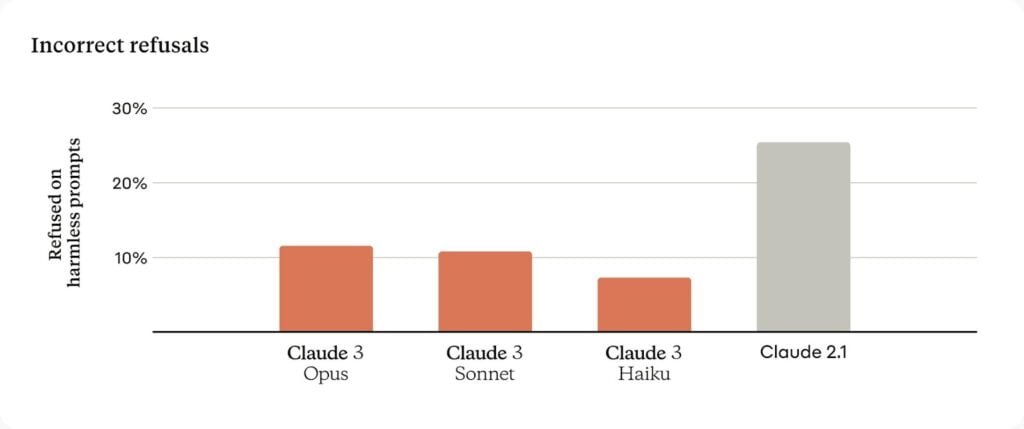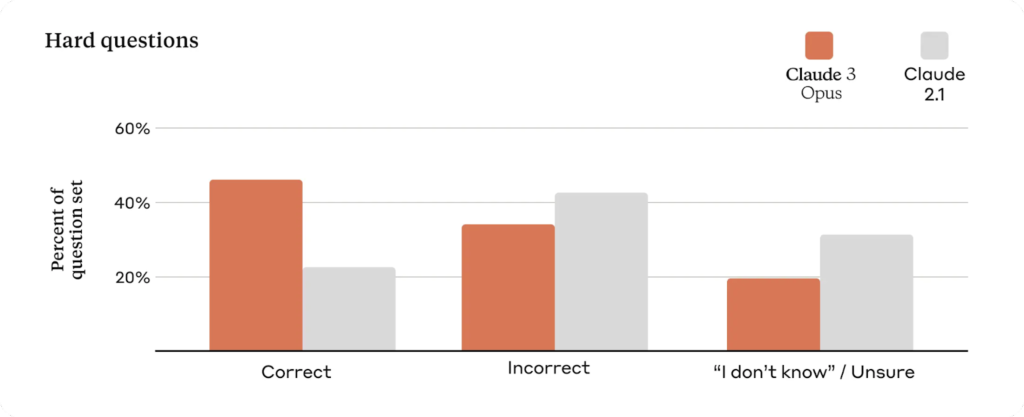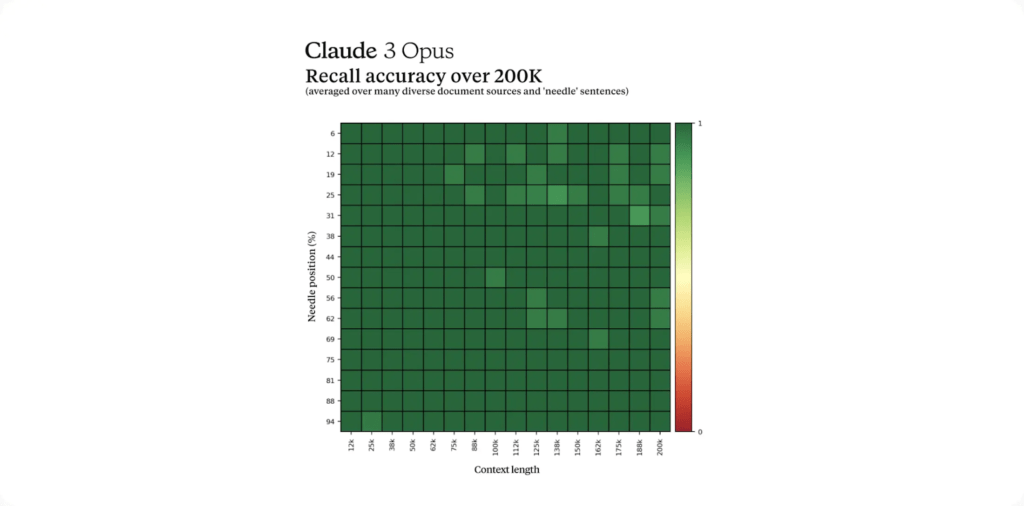We’re excited to introduce the Claude 3 model family today, a new standard in the field of cognitive technology. This family comprises three advanced models, each designed to excel in a variety of cognitive tasks. Starting with Claude 3 Haiku, followed by Claude 3 Sonnet. And leading up to Claude 3 Opus, these models are arranged in order of their capabilities. As you move from Haiku to Opus, you’ll find that each model offers a step up in performance, giving you the flexibility to choose the perfect mix of speed, intelligence, and affordability for your needs.
Both the Opus and Sonnet models are now ready for you to explore on claude.ai and through the Claude API, accessible in an impressive 159 countries. And keep an eye out for Haiku, which we’ll be launching shortly
The Claude 3 Model Family: Overview

A New Standard for Intelligence
The Claude 3 family consists of three models: Claude 3 Haiku, Claude 3 Sonnet, and Claude 3 Opus, each designed to cater to varying levels of performance and application needs. Opus stands out as the flagship model, boasting unmatched intelligence and the ability to outperform existing AI systems across multiple benchmarks, including undergraduate and graduate-level expertise, basic mathematics, and more. Its near-human comprehension and fluency set a new benchmark in the realm of general intelligence.

Global Availability and Accessibility
Opus and Sonnet are now accessible via claude.ai and the Claude API, marking a significant milestone with availability in 159 countries. Haiku, known for its speed and cost-effectiveness, will join its siblings shortly, promising to revolutionize the way we interact with AI.
Distinguishing Features of the Claude 3 Models
Near-Instant Results
The Claude 3 family excels in delivering immediate, real-time responses. Haiku leads in speed and affordability, whereas Sonnet offers twice the speed of its predecessors without compromising intelligence. Opus matches the speed of previous models but elevates the level of intelligence significantly.
Enhanced Vision Capabilities
With advanced vision capabilities, the Claude 3 models process a wide array of visual formats, extending their utility to enterprise customers who rely on diverse knowledge bases.

Fewer Refusals and Improved Accuracy
Significant improvements have been made in reducing unnecessary refusals and enhancing accuracy. The models demonstrate a nuanced understanding of requests, minimizing incorrect responses and demonstrating a commitment to reliable output.

Enhanced Precision in AI Performance
Organizations of every scale depend on our AI solutions to meet their customer service standards, emphasizing the critical need for precision in our model outputs across extensive use cases. Our approach involves a comprehensive evaluation using a vast array of complex. Real-world questions designed to probe the weaknesses of existing AI models. This process allows us to classify responses into accurate answers, inaccuracies (or misinterpretations), and instances of uncertainty where the model opts to withhold an incorrect response. The latest iteration, Claude3 Opus, showcases a remarkable improvement in delivering correct responses to complex queries, doubling the accuracy rate found in Claude 2.1, and significantly reducing inaccuracies.
Future updates will introduce citation capabilities in the Claude 3 models, enhancing the trustworthiness of responses by referencing specific segments of source materials to validate their answers.

Advancements in Contextual Understanding and Recall
Upon release, the Claude models are equipped with a 200K token context window, with capabilities that extend to processing inputs of over 1 million tokens for selected high-demand applications. Effective processing of extensive context requires sophisticated recall abilities. Our “Needle In A Haystack” (NIAH) evaluation, strengthened by incorporating random needle/question pairs across a varied document corpus, assesses this capability. Claude3 Opus notably exceeds expectations with near-perfect recall rates, even highlighting potential evaluation flaws by detecting artificially inserted content within texts.

Commitment to Ethical AI Development
The Claude 3 models are crafted with integrity at their core. Monitored by dedicated teams aimed at mitigating risks from misinformation to privacy concerns, employing strategies like Constitutional AI to bolster model safety and transparency. Efforts to diminish biases have advanced significantly with this release. As evidenced by the improved neutrality in the Bias Benchmark for Question Answering (BBQ) assessments. Our goal is to continue refining our techniques to ensure our models present balanced views without favoring any political or ideological biases.
Despite notable advancements in areas such as biological comprehension, cybersecurity. And autonomous operation, Claude 3 models maintain an AI Safety Level 2 (ASL-2) standing under our Responsible Scaling Policy. Rigorous evaluations, aligned with our commitment to the White House and the 2023 US Executive Order. Affirm the minimal risk these models pose regarding potential catastrophic outcomes. We remain vigilant, continuously assessing the evolution of our models to safeguard against any future risks, as detailed in the Claude 3 model card
Model Comparison and Application Potential
Claude 3 Opus: The Pinnacle of AI Intelligence
Opus represents the zenith of AI capabilities, offering unparalleled performance in navigating complex scenarios. It is desiging for high-end applications like task automation, research and development, and strategic analysis.
Claude 3 Sonnet: Balancing Speed and Intelligence
Sonnet is engineered for efficiency, providing strong performance at a more accessible cost. It is ideal for data processing, sales enhancement, and time-saving tasks, making it a versatile tool for enterprise applications.
Claude 3 Haiku: Unmatched Speed and Efficiency
Haiku is tailored for instant responsiveness, perfect for customer interactions, content moderation, and optimized logistics. Its unmatched speed and affordability make it an excellent choice for rapid, accurate support.
A Safer, More Responsible AI
The development of the Claude3 model family emphasizes safety and responsibility. With dedicated teams to mitigate risks and continuous efforts to address biases. These models are desiging to be as trustworthy as they are capable. The models remain at AI Safety Level 2, ensuring negligible potential for catastrophic risk.
Empowering Users and Advancing AI
The Claude 3 models not only push the boundaries of AI capabilities but also prioritize user ease and safety. With the promising of frequent updates and new features, the Claude 3 family is poised to significantly enhance enterprise use cases and large-scale deployments.
As we stand on the brink of a new era in AI, the Claude 3 model family invites developers. Businesses, and innovators to explore the limits of what’s possible. With Claude3, we are stepping into a future where AI is smarter. Faster, and safer, promising to unlock unprecedented possibilities for society.
Conclusion
The launch of the Claude 3 model family marks a significant milestone in AI development. By offering a range of models that cater to different needs. Claude 3 ensures that users can find the perfect balance of intelligence. Speed, and cost. As we move forward, the potential applications of these models are vast and varied. Promising to revolutionize industries and redefine our interaction with technology. The future of AI is here, and it’s embodied in the Claude3 model family.
Also Read :-
Joining the AI Revolution with Alibaba’s EMO AI: Bringing Portraits to Life
Introducing Gemma: Google’s New Open Models for AI Development
The Scope of Artificial Intelligence in India
Exploring the Frontiers of AI in 2023: Breakthroughs and Challenges
The Role Of Artificial Intelligence In Education
The Amazing Rise of Claude 2.1: Giving Best AI Potential

